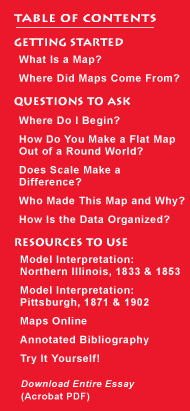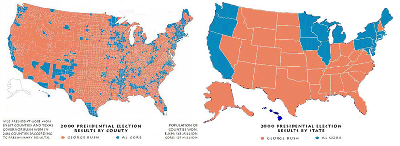talking history | syllabi | students | teachers | puzzle | about us
 |
Classification is a second part of cartographic generalization. It involves reducing data to a form that can be easily represented on a map. An example of this type of generalization would be to arrange data on poverty into five classes of counties with each group having a mutually exclusive value range. With this arrangement the map reader can get a sense of the spatial pattern of the data without having to examine the value for each individual county. Here again is the opportunity for skullduggery. Ken Foote's Geographer's Craft has a section on issues of statistical generalization that offers a good illustration of this truth. To represent elements of the physical and cultural landscape on a map, they must be reduced in complexity and then fitted into a scheme so that their meaning can be understood by a map reader. Cities are shown as dots of differing sizes, blue lines represent streams, and regions are defined by colored polygons. This cartographic shorthand involves a third part of generalization, that of symbolization. Well-made maps have a legend or key that explains the meaning of each type of symbol used on a map. Without this information, a map is difficult to interpret. Differences in symbols' shapes, sizes, hues, orientations, gray tone values, and textures are properties that are used to denote spatial and quantitative variation on a map. As with projections, the use of inappropriate symbols can convey erroneous information, and, as with projections, symbols can be manipulated to create false impressions. Again Foote's website offers a good explanation of how cartographers utilize symbols.The final part of cartographic generalization is induction. This occurs where the map contains more information than was in the original data. For example, with a phenomenon that has a continuous distribution like elevation or rainfall, one can infer the elevation or rainfall total at any point on a map, yet the data used to create that map may have been only a few points with known elevations or rainfall totals. Such maps are only approximations of reality. The greater the number of data points used to create them, the better their approximation of the truth. As discomforting as it may be, you need to understand that no map is a totally truthful representation of the world. All maps are lies. Some lie more than others. To ferret out the truth you need to know how to decode the messages of maps and place maps into their historical context.
When you are done, click here for further explanation.
|
|||||
 |
||||||



